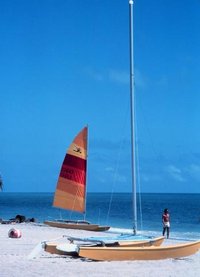Catamaran
|
|
A catamaran is a type of boat (or occasionally ship) consisting of two hulls joined by a frame. Catamarans can be sail- or motor-powered. The word catamaran comes from the Tamil language, in which the word kattumaram means "logs bound together". The catamaran was the invention of the paravas, an aristocratic fishing community in the southern coast of Tamilnadu, India.
Catamarans are a relatively recent design of boat for both leisure and sport sailing, although they have been used for millennia in Oceania, where Polynesian catamarans allowed seafaring Polynesians to settle the world's most far-flung islands. Catamarans have been met by a degree of scepticism from some sailors accustomed to more "traditional" designs.
| Contents |
Catamaran sailing
Although the principles of sailing are the same for both catamarans and monohulls, there are some 'peculiarities' to sailing catamarans. For example:
- Catamarans can be harder to tack (turn through the wind). Because they are lighter in proportion to their sail size, they have less momentum to carry them through the turn when they are head to wind.
- They have a higher average speed.
- All boats sail faster when travelling in certain directions relative to the wind the best speeds typically being achieved when heading away from the wind at about 135 degrees. This effect is much more noticeable with catamarans, even to the extent that it can be more efficient to jibe ('tack' downwind) in zig zags, rather than heading directly away from the wind as a monohull would.
- Catamarans are less likely to capsize in the classic 'beam-wise' manner but often have a tendency to 'pole-axe' (or 'pitchpole') instead - where the leeward (downwind) bow sinks into the water and the boat 'trips' over forward, leading to a capsize.
Teaching for new sailors is usually carried out in monohulls as they are thought easier to learn to sail, a mixture of all the differences mentioned probably contributes to this.
KZ1vsCAT.jpg
Catamarans, and multihulls in general, are normally faster than single-hull boats for four reasons:
- each hull of a catamaran is (typically) thinner in cross section than those of monohulls;
- catamarans are lighter due to the fact there is no keel counterweight.
- catamarans have a wider beam (the distance from one side of the boat to the other), which makes them more stable and therefore able to carry more sail area per metre of length than an equivalent monohull.
- the greater stability means that the sail is more likely to stay upright in a gust, drawing more power than a monohull's sail which is more likely to lean over.
Catamarans are especially favourable in coastal waters, where the open spaces permit the boat to reach and maintain its maximum speed. Catamarans make good cruising and long distance boats: The Race (around the world, in 2001) was won by the giant catamaran Club Med skippered by Grant Dalton. It went round the earth in 62 days at an average speed of eighteen knots.
Catamaran designs
Popular small racing catamarans include:
- The Hobie cats
- International A-Class (open design; length 5.49 m (18 ft), beam 2.3 m (7 ft 6.5 in), weight 75 kg, sail 13.94 m² (150 ft²))
- Dart 15 and Dart 18
- Tornado, Olympic class racing catamaran.
Catamarans for ferries:
- Discovery, Stena Line, between Harwich, UK and Hoek van Holland, Netherlands [1] (http://www.stenaline.com/Vessels/Discovery_inc.htm)
- Lake Express running between Milwaukee, Wisconsin and Muskegon, Michigan
- Spirit of Ontario I running between Rochester, New York and Toronto, Ontario
- SSTH Ocean Arrow
- SuperStar Express, P&O Irish Sea running between Troon, Scotland and Belfast, Northern Ireland.
- FoilCat, FlyingCat and Tricat operated by Turbojet Ferry, running between Hong Kong and Macau.
See also
Template:Sailing Vessels and Rigs
External links
- http://www.sailing.org/ International Sailing Federation
- http://www.catamaran.co.uk/main.htm
- A list of different hull designs (http://www.yachtboutique.com/BugattiYachts/Advanced_Hulls.htm)da:Katamaran
de:Katamaran fr:Catamaran nl:Catamaran ja:双胴船 pl:Katamaran fi:Katamaraani sv:Katamaran


